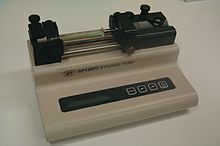Syringe driver

A syringe driver, also known as a syringe pump, is a small infusion pump, used to gradually administer small amounts of fluid (with or without medication) to a patient or for use in chemical and biomedical research. Some syringe drivers can both infuse and withdraw solutions.
Uses
Syringe drivers can be used for electrospinning, electrospraying, microdialysis, microfluidics, dispensing/dilution, tissue perfusion, and fluid circulation.
Intravenous therapy
Syringe drivers are useful for delivering intravenous (IV) therapies over several minutes. They infuse solutions at a constant rate.[1] In the case of a medication which should be slowly pushed in over the course of several minutes, this device saves staff time and reduces medical errors. It is useful for patients who cannot take medicines orally (such as those with difficulty swallowing), and for medications too harmful to be taken orally.[2]
Palliative care
Syringe drivers are particularly useful in
Research
Syringe pumps are useful in microfluidic applications, such as microreactor design and testing, and also in chemistry for slow incorporation of a fixed volume of fluid into a solution. In
References
- ISBN 978-0-7020-4443-4, retrieved 2021-01-13
- ^ a b "How do I administer anti-emetic drugs via a syringe driver?". NICE. October 2016. Retrieved 13 January 2021.
- ISBN 0-7167-1614-3.
- .
- .
